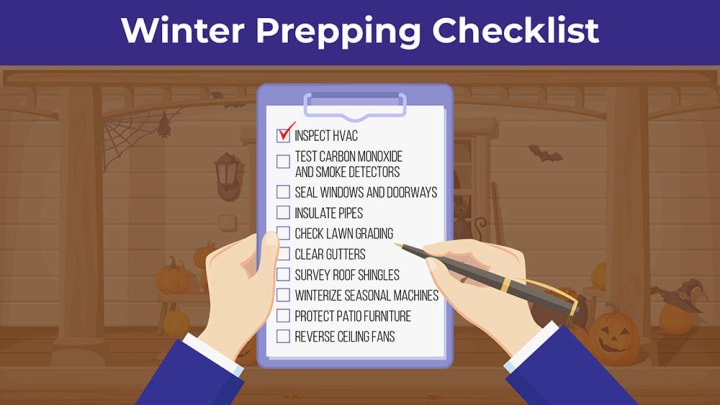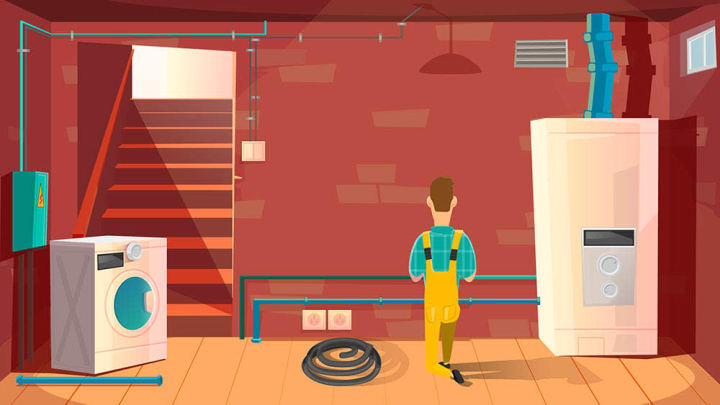Do I Need to Prep My Home for Winter?

Like it or not, winter is fast approaching. Gone are hot, sticky summer days and nights as we snowball towards the winter solstice. Even Californians and Texans experience below-average temperatures this time of the year, especially during the evening time! But, for those of us who live in notoriously colder states with vast variations in seasonal weather, fall is an indicator of the ice-cold, bitter months ahead.
Whether your winters are filled with piles of snow, sheets of ice, or simply bone-chilling air, below-freezing weather can damage all sorts of your belongings, especially items that make your house a home. From your HVAC system to your home’s plumbing, Old Man Winter can really throw your equipment for a frigid loop. Ranging from expensive repairs to complete replacements, damage from falling temps can leave you stuck out in the cold during the harshest winter months.
As temperatures begin to drop near you, so does the health of your home and your belongings if they aren’t properly taken care of. So, to help turn your home and your belongings into winter weather fortresses this year, we’ve put together a list of winter home tips before the cold settles in for the long haul.
Cold Weather Tips for Home

Winter Prepping Checklist
- Inspect HVAC
- Test carbon monoxide and smoke detectors
- Seal windows and doorways
- Insulate pipes
- Check lawn grading
- Clear gutters
- Survey roof shingles
- Winterize seasonal machines
- Protect patio furniture
- Reverse ceiling fans
Prep Your HVAC
Your heating, ventilation, and air conditioning (HVAC) unit is likely your home’s most valuable item when it comes to winter weather. In order to combat the bitter cold, your HVAC unit needs to be in tip-top shape for optimal performance. At the very least, you should replace your HVAC’s filters before the end of fall to ensure adequate filtration and warm airflow during the winter months.
To take it one step further, you should hire an HVAC contractor to inspect your unit thoroughly, diagnosing any issues or needed repairs proactively to avoid breakdowns during the peak of winter. Want to take the worry out of checking your unit entirely? You can sign up for annual HVAC inspections from a local contractor to ensure the heat keeps flowing no matter how low the temperatures get.
Test Your Carbon Monoxide and Smoke Detectors
Because your HVAC will likely be working overtime to keep your home warm, make sure your carbon monoxide (CO) and smoke detectors are in working order. As your home will likely be sealed tight to retain heat, carbon monoxide build-up can go unnoticed if the proper precautions aren’t in place. Dryer temperatures and less humidity can lead to higher chances of a fire, too.
Seal Your Windows and Doorways
When a window or a door doesn’t fit perfectly in its frame, it allows your valuable warm air to escape while letting cold air into your home. Over time, the components of your windows and doors—such as weather stripping, caulk work, door sweeps, glazing putty, window gaskets, and wooden frames—can wear out and provide imperfect seals. Inspect all of your windows and doors and replace any worn-out components before winter.
Insulate Your Plumbing

The plumbing routed throughout your home is vulnerable to extreme fluctuations in temperature, especially pipes that are located outdoors or in areas that don’t receive a lot of heat. When liquid in a pipe freezes, it expands in volume and generates higher pounds per square inch (PSI), generating a tremendous amount of pressure inside of the pipe.
Eventually, the pipe will crack or burst open in the frozen area or wherever the highly pressurized water finds a weak spot. Pipes that burst due to freezing will eventually thaw out, meaning they will begin to release water throughout your drywall, onto your flooring, or within your cabinetry.
To keep your pipes from freezing and bursting, there are a few things you can do to keep the cold points of your plumbing warm:
Maintain Warmth in Your Pipes
Insulation sleeves, wrapping, or foam-pipe insulation can do wonders to retain heat within your pipes, but make sure to place the insulation across all areas of exposed pipe. Small, exposed areas without insulation can still be damaged from the cold.
Turn Up the Heat
As simple as this sounds, getting more heat to colder areas can be key in keeping your pipes warm. If certain areas of your home don’t retain heat well, you can utilize space heaters or fans to push warmer air to that location. Additionally, you can simply turn your thermostat up during extremely cold days to raise the ambient temperature everywhere.
Let the Sink Drip
Allowing a sink to maintain a slow drip can prevent water in your pipes from freezing, as the water is continuously moving and flowing throughout the pipe.
Disconnect Garden Hoses
Wall-mounted hose valves—or spigots—can easily burst in the winter due to lack of use. Make sure to shut off the valve’s main water supply, drain the hose and valve of any leftover water, and cover the valve spout with an insulated cover.
Check Your Lawn’s Grade
Grading—or gently sloping your lawn away from your foundation—is critical to avoid foundation issues from freezing weather. Soil that retains water around your foundation will continuously freeze and expand throughout the winter, putting immense pressure on your foundation.
To prevent excessive pressure build-up around your foundation, walk the perimeter of your home to see if there are any flat spots in the soil where water can pool. If you find any, pack them with dirt and slope the mound away from your home.
Clear Your Gutters
As fall comes to a close, make sure to inspect your gutters for any leaves or debris from surrounding trees and clear out any clogs. If your gutters remain clogged throughout winter, rain, snow, or ice melt will end up overflowing, forcing water to run down your siding and straight into the soil that surrounds your foundation.
Additionally, it’s important to investigate the soil surrounding your downspouts, as you want to ensure water is flowing away from your foundation properly. If you notice any pooling from your downspouts, consider attaching downspout extenders to guide moisture farther away.
Survey Your Shingles
Damaged roof shingles—including individual shingles with holes or tears—can pave the way for water to get through to your felt or synthetic underlayment and roof deck. If the solid wood decking of your roof gets wet, it could cause severe structural damage and expensive repairs. If you notice a shingle or two are damaged, try calling in a professional roofer to replace them.
The support beams underneath your roof deck are also important to consider, as snowfall can add a massive amount of weight to load-bearing beams holding the basic structure of your roof together. Have a professional inspect the support beams in your attic for any cracks or weak points, as bracing these beams can provide continued support to your entire roof.
Winterize Seasonal Machines

From lawnmowers to power washers, winterize your seasonal motorized vehicles if they are going unused for long periods of time. When gas sits in a tank unused, it can gum up your fuel filters and cause your machine to run poorly. To prevent internal damage to your machines, you can:
- Siphon the gas from the tanks
- Run your machines out of gas before winter
- Add a fuel stabilizer to the tanks
These tools are expensive investments, so make sure to take care of them even when they aren’t in use.
Protect Your Patio Furniture
Much like lawn care tools and motorized vehicles, patio furniture is a valuable investment. If left exposed to the elements throughout winter, your lawn chairs and tables can rot or rust from excessive moisture. Before winter begins, store your patio furniture in a dry area or place covers over them to safeguard their well-being. This goes for your outdoor grill, too!
Reverse Your Fans
If you have ceiling fans that feature a reverse spin setting, use it! Ceiling fans that spin in reverse will produce an updraft, forcing warm air near the ceiling downwards. This is a quick and easy way to keep warmer air near you rather than rising upwards.
Get Ready for the Big Chill

Once your home and belongings have been prepared for winter, you can focus on ensuring you have all the tools at your disposal when inclement weather strikes, including:
- Ice melt (driveway salt)
- Windshield ice scraper
- Durable, warm winter gloves
- Waterproof winter boots
- Emergency winter coat in your vehicle
- Snow shovel or snowblower
- Up-to-date fire extinguisher
- Flashlights and extra batteries
- Backup space heater
- Backup power generator
These items can help you in a pinch this winter, especially if seasonal storms cause power outages or if your vehicle breaks down in the snow.
How Climate-Controlled Self Storage at Devon Can Help
While these cold-weather tips for your home can help you stay prepared for winter, lack of storage space can’t be remedied without self storage. From all of your seasonal tools to your expensive patio furniture, acquiring a climate-controlled storage unit can help alleviate a crowded, cluttered mess at home this winter while keeping your valuables warm and out of the elements.
Rather than stuffing your garage full of unused belongings—including additional cars, boats, or other motor vehicles—you can save much-needed space in and around your home with help from Devon Self Storage.
Call Devon Today to Keep Your Belongings Cozy this Winter
With units ranging from 5×5 spaces to enclosed parking units for RVs, our self storage solutions can help you save space this winter while protecting your belongings. Find a Devon facility near you today to get a jumpstart on winter prep!